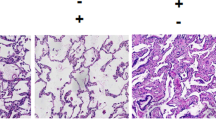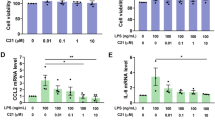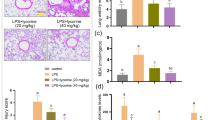Abstract—
Acute lung injury (ALI) is mainly caused by severe infection, shock, trauma, and burn, which causes the extensive release of inflammatory factors and other mediators. As a major bioactive constituent of traditional Chinese herb licorice, glycyrrhizic acid (GA) plays an important effect on inflammatory regulation. Nevertheless, the exact mechanism of this effect remains unclear. The present study aims to explore the potential protective effect of GA on LPS-induced ALI. Our results showed that GA significantly attenuated LPS-induced ALI and decreased the production of inflammatory factors, including IL-1β, MCP-1, COX2, HMGB1, and adhesion molecules, such as E-selectin, VCAM-1, and modulated expression of angiotensin-converting enzyme 2 (ACE2). Moreover, treatment of ACE2 inhibitor (MLN-4760) reversed the effects of GA on the secretion of pro-inflammatory factors in ALI. Additionally, GA exerts its protective effect by regulating the ACE2 and caveolin-1/NF-κB signaling pathway. In conclusion, this study showed that GA alleviated LPS-induced ALI by upregulating ACE2 and inhibiting the caveolin-1/NF-κB signaling pathway.







Similar content being viewed by others
Abbreviations
- ALI:
-
Acute lung injury
- ACE2:
-
Angiotensin converting enzyme 2
- COX-2:
-
Cyclooxygenase-2
- GA:
-
Glycyrrhizic acid
- HUVECs:
-
Human umbilical vein endothelial cells
- HMGB1:
-
High-mobility group box 1
- IL-1β:
-
Interleukin-1β
- LPS:
-
Lipopolysaccharide
- MCP-1:
-
Monocyte chemotactic factor 1
References
Filgueiras, L.R. Jr., J.O. Martins, C.H. Serezani, V.L. Capelozzi, M.B. Montes, S. Jancar. 2012. Sepsis-induced acute lung injury (ALI) is milder in diabetic rats and correlates with impaired NFkB activation. PLoS One 7:e44987.
Wheeler, A.P., and G.R. Bernard. 2007. Acute lung injury and the acute respiratory distress syndrome: A clinical review. Lancet 369: 1553–1564.
Dushianthan, A., M.P. Grocott, A.D. Postle, and R. Cusack. 2011. Acute respiratory distress syndrome and acute lung injury. Postgraduate Medical Journal 87: 612–622.
Afshari, A., J. Brok, A.M. Moller, J. Wetterslev. 2010. Aerosolized prostacyclin for acute lung injury (ALI) and acute respiratory distress syndrome (ARDS). Cochrane Database Syst Rev CD007733.
Laffey, J.G., B.P. Kavanagh. 2000. Ventilation with lower tidal volumes as compared with traditional tidal volumes for acute lung injury. New England Journal of Medicine 343:812; author reply 813–814.
Wang, X., L. Zhang, W. Duan, B. Liu, P. Gong, Y. Ding, and X. Wu. 2014. Anti-inflammatory effects of triptolide by inhibiting the NF-kappaB signalling pathway in LPS-induced acute lung injury in a murine model. Molecular Medicine Reports 10: 447–452.
Fang, Y., F. Gao, J. Hao, and Z. Liu. 2017. microRNA-1246 mediates lipopolysaccharide-induced pulmonary endothelial cell apoptosis and acute lung injury by targeting angiotensin-converting enzyme 2. American Journal of Translational Research 9: 1287–1296.
Yan, J., J. Li, L. Zhang, Y. Sun, J. Jiang, Y. Huang, H. Xu, H. Jiang, and R. Hu. 2018. Nrf2 protects against acute lung injury and inflammation by modulating TLR4 and Akt signaling. Free Radical Biology & Medicine 121: 78–85.
Cheng, K.T., S. Xiong, Z. Ye, Z. Hong, A. Di, K.M. Tsang, X. Gao, S. An, M. Mittal, S.M. Vogel, et al. 2017. Caspase-11-mediated endothelial pyroptosis underlies endotoxemia-induced lung injury. The Journal of Clinical Investigation 127: 4124–4135.
Ye, S., Y. Zhu, Y. Ming, X. She, H. Liu, and Q. Ye. 2014. Glycyrrhizin protects mice against renal ischemia-reperfusion injury through inhibition of apoptosis and inflammation by downregulating p38 mitogen-activated protein kinase signaling. Experimental and Therapeutic Medicine 7: 1247–1252.
Farooqui, A., F. Khan, I. Khan, and I.A. Ansari. 2018. Glycyrrhizin induces reactive oxygen species-dependent apoptosis and cell cycle arrest at G0/G1 in HPV18(+) human cervical cancer HeLa cell line. Biomedicine & Pharmacotherapy 97: 752–764.
Qu, L., C. Chen, W. He, Y. Chen, Y. Li, Y. Wen, S. Zhou, Y. Jiang, X. Yang, R. Zhang, and L. Shen. 2019. Glycyrrhizic acid ameliorates LPS-induced acute lung injury by regulating autophagy through the PI3K/AKT/mTOR pathway. American Journal of Translational Research 11: 2042–2055.
Turner, A.J., J.A. Hiscox, and N.M. Hooper. 2004. ACE2: From vasopeptidase to SARS virus receptor. Trends in Pharmacological Sciences 25: 291–294.
Fraga-Silva, R.A., F.P. Costa-Fraga, T.M. Murca, P.L. Moraes, A. Martins Lima, R.Q. Lautner, C.H. Castro, C.M. Soares, C.L. Borges, A.P. Nadu, et al. 2013. Angiotensin-converting enzyme 2 activation improves endothelial function. Hypertension 61: 1233–1238.
Lin, C.I., C.H. Tsai, Y.L. Sun, W.Y. Hsieh, Y.C. Lin, C.Y. Chen, C.S. Li. 2018. Instillation of particulate matter 2.5 induced acute lung injury and attenuated the injury recovery in ACE2 knockout mice. International Journal of Biological Sciences 14:253–265.
He, H.L., L. Liu, Q.H. Chen, S.X. Cai, J.B. Han, S.L. Hu, P. Chun, Y. Yang, F.M. Guo, Y.Z. Huang, and H.B. Qiu. 2015. MSCs modified with ACE2 restore endothelial function following LPS challenge by inhibiting the activation of RAS. Journal of Cellular Physiology 230: 691–701.
Jin, H.Y., B. Song, G.Y. Oudit, S.T. Davidge, H.M. Yu, Y.Y. Jiang, P.J. Gao, D.L. Zhu, G. Ning, Z. Kassiri, et al. 2012. ACE2 deficiency enhances angiotensin II-mediated aortic profilin-1 expression, inflammation and peroxynitrite production. PLoS One 7:e38502.
Romeo, G.R., K.S. Moulton, and A. Kazlauskas. 2007. Attenuated expression of profilin-1 confers protection from atherosclerosis in the LDL receptor null mouse. Circulation Research 101: 357–367.
van Deurs, B., K. Roepstorff, A.M. Hommelgaard, and K. Sandvig. 2003. Caveolae: Anchored, multifunctional platforms in the lipid ocean. Trends in Cell Biology 13: 92–100.
Frank, P.G., M.W. Cheung, S. Pavlides, G. Llaverias, D.S. Park, and M.P. Lisanti. 2006. Caveolin-1 and regulation of cellular cholesterol homeostasis. American Journal of Physiology. Heart and Circulatory Physiology 291: H677-686.
Zou, W., X. Ma, W. Hua, B. Chen, and G. Cai. 2015. Caveolin-1 mediates chemoresistance in cisplatin-resistant ovarian cancer cells by targeting apoptosis through the Notch-1/Akt/NF-kappaB pathway. Oncology Reports 34: 3256–3263.
Xiang, Q., G. Lin, J. Xu, S. Zheng, S. Chen, K. Zhou, and T. Wang. 2010. The role of caveolin1 and sprouty1 in genistein’s regulation of vascular smooth muscle cell and endothelial cell proliferation. European Journal of Pharmacology 648: 153–161.
Garrean, S., X.P. Gao, V. Brovkovych, J. Shimizu, Y.Y. Zhao, S.M. Vogel, and A.B. Malik. 2006. Caveolin-1 regulates NF-kappaB activation and lung inflammatory response to sepsis induced by lipopolysaccharide. The Journal of Immunology 177: 4853–4860.
Zhang, Y., W. Yu, D. Han, J. Meng, H. Wang, G. Cao. 2019. L-lysine ameliorates sepsis-induced acute lung injury in a lipopolysaccharide-induced mouse model. Biomed Pharmacother 118:109307.
Oshima, K., X. Han, Y. Ouyang, R. El Masri, Y. Yang, S.M. Haeger, S.A. McMurtry, T.C. Lane, P. Davizon-Castillo, F. Zhang, et al. 2019. Loss of endothelial sulfatase-1 after experimental sepsis attenuates subsequent pulmonary inflammatory responses. American Journal of Physiology-Lung Cellular and Molecular Physiology
Wang L., Y. Cao, B. Gorshkov, Y. Zhou, Q. Yang, J. Xu, Q. Ma, X. Zhang, J. Wang, X. Mao, et al. 2019. Ablation of endothelial Pfkfb3 protects mice from acute lung injury in LPS-induced endotoxemia. Pharmacological Research 146:104292.
Wang, K., R. Xu, A.J. Snider, J. Schrandt, Y. Li, A.B. Bialkowska, M. Li, J. Zhou, Y.A. Hannun, L.M. Obeid, et al. 2016. Alkaline ceramidase 3 deficiency aggravates colitis and colitis-associated tumorigenesis in mice by hyperactivating the innate immune system. Cell Death and Disease 7:e2124.
Pinheiro, A., A.R.S. Mendes, M. Neves, C.M. Prado, Bittencourt-Mernak MI, Santana FPR, Lago, J.H.G., J.C. de Sa, C.Q. da Rocha, E.M. de Sousa, et al. 2019. Galloyl-Hexahydroxydiphenoyl (HHDP)-Glucose Isolated From Punica granatum L. Leaves Protects Against Lipopolysaccharide (LPS)-Induced Acute Lung Injury in BALB/c Mice. Front Immunol 10:1978.
Cunha, J.M., F.Q. Cunha, S. Poole, and S.H. Ferreira. 2000. Cytokine-mediated inflammatory hyperalgesia limited by interleukin-1 receptor antagonist. British Journal of Pharmacology 130: 1418–1424.
Xu, X.G., and H.D. Chen. 2018. Prostanoids and Hair Follicles: Implications for Therapy of Hair Disorders. Acta Dermato Venereologica 98: 318–323.
Lee, S.A., S.H. Lee, J.Y. Kim, and W.S. Lee. 2019. Effects of glycyrrhizin on lipopolysaccharide-induced acute lung injury in a mouse model. Journal of Thoracic Disease 11: 1287–1302.
Bongoni, A.K., N. Klymiuk, E. Wolf, D. Ayares, R. Rieben, and P.J. Cowan. 2016. Transgenic Expression of Human Thrombomodulin Inhibits HMGB1-Induced Porcine Aortic Endothelial Cell Activation. Transplantation 100: 1871–1879.
Lee, W., K.M. Kim, and J.S. Bae. 2015. Ameliorative Effect of Aspalathin and Nothofagin from Rooibos (Aspalathus linearis) on HMGB1-Induced Septic Responses In Vitro and In Vivo. American Journal of Chinese Medicine 43: 991–1012.
Rashid, S., S. Nafees, A. Siddiqi, A. Vafa, S.M. Afzal, R. Parveen, N. Ali, S.K. Hasan, P. Barnwal, A. Shahid, and S. Sultana. 2017. Partial protection by 18beta Glycrrhetinic acid against Cisplatin induced oxidative intestinal damage in wistar rats: Possible role of NFkB and caspases. Pharmacological Reports 69: 1007–1013.
Menegazzi, M., R. Di Paola, E. Mazzon, T. Genovese, C. Crisafulli, M. Dal Bosco, Z. Zou, H. Suzuki, and S. Cuzzocrea. 2008. Glycyrrhizin attenuates the development of carrageenan-induced lung injury in mice. Pharmacological Research 58: 22–31.
Ni, Y.F., J.K. Kuai, Z.F. Lu, G.D. Yang, H.Y. Fu, J. Wang, F. Tian, X.L. Yan, Y.C. Zhao, Y.J. Wang, and T. Jiang. 2011. Glycyrrhizin treatment is associated with attenuation of lipopolysaccharide-induced acute lung injury by inhibiting cyclooxygenase-2 and inducible nitric oxide synthase expression. Journal of Surgical Research 165: e29-35.
Fu, J., S.H. Lin, C.J. Wang, S.Y. Li, X.Y. Feng, Q. Liu, and F. Xu. 2016. HMGB1 regulates IL-33 expression in acute respiratory distress syndrome. International Immunopharmacology 38: 267–274.
Lisanti, M.P., P.E. Scherer, Z. Tang, and M. Sargiacomo. 1994. Caveolae, caveolin and caveolin-rich membrane domains: A signalling hypothesis. Trends in Cell Biology 4: 231–235.
Wang, X.M., H.P. Kim, R. Song, and A.M. Choi. 2006. Caveolin-1 confers antiinflammatory effects in murine macrophages via the MKK3/p38 MAPK pathway. American Journal of Respiratory Cell and Molecular Biology 34: 434–442.
Zhu, X., Y. Zhang, Q. Li, L. Yang, N. Zhang, S. Ma, K. Zhang, J. Song, and F. Guan. 2016. beta-Carotene Induces Apoptosis in Human Esophageal Squamous Cell Carcinoma Cell Lines via the Cav-1/AKT/NF-kappaB Signaling Pathway. Journal of Biochemical and Molecular Toxicology 30: 148–157.
Liu, S.F., and A.B. Malik. 2006. NF-kappa B activation as a pathological mechanism of septic shock and inflammation. American Journal of Physiology. Lung Cellular and Molecular Physiology 290: L622–L645.
Karin, M. 1999. The beginning of the end: IkappaB kinase (IKK) and NF-kappaB activation. Journal of Biological Chemistry 274: 27339–27342.
Fernandez-Pisonero, I., A.I. Duenas, O. Barreiro, O. Montero, F. Sanchez-Madrid, and C. Garcia-Rodriguez. 2012. Lipopolysaccharide and sphingosine-1-phosphate cooperate to induce inflammatory molecules and leukocyte adhesion in endothelial cells. The Journal of Immunology 189: 5402–5410.
Zhang, Z., N. Chen, J.B. Liu, J.B. Wu, J. Zhang, Y. Zhang, and X. Jiang. 2014. Protective effect of resveratrol against acute lung injury induced by lipopolysaccharide via inhibiting the myd88-dependent Toll-like receptor 4 signaling pathway. Molecular Medicine Reports 10: 101–106.
Cortez, M., L.S. Carmo, M.M. Rogero, P. Borelli, and R.A. Fock. 2013. A high-fat diet increases IL-1, IL-6, and TNF-alpha production by increasing NF-kappaB and attenuating PPAR-gamma expression in bone marrow mesenchymal stem cells. Inflammation 36: 379–386.
Liang, W.J., X.Y. Zeng, S.L. Jiang, H.Y. Tan, M.Y. Yan, H.Z. Yang. 2019. Long non-coding RNA MALAT1 sponges miR-149 to promote inflammatory responses of LPS-induced acute lung injury by targeting MyD88. Cell Biology International
Yu, X., L. Cui, F. Hou, X. Liu, Y. Wang, Y. Wen, C. Chi, C. Li, R. Liu, and C. Yin. 2018. Angiotensin-converting enzyme 2-angiotensin (1–7)-Mas axis prevents pancreatic acinar cell inflammatory response via inhibition of the p38 mitogen-activated protein kinase/nuclear factor-kappaB pathway. International Journal of Molecular Medicine 41: 409–420.
Qiu, Y., L. Tao, S. Zheng, R. Lin, X. Fu, Z. Chen, C. Lei, J. Wang, H. Li, Q. Li, and B. Lei. 2016. AAV8-Mediated Angiotensin-Converting Enzyme 2 Gene Delivery Prevents Experimental Autoimmune Uveitis by Regulating MAPK, NF-kappaB and STAT3 Pathways. Science and Reports 6: 31912.
Peritore, A.F., R. D'Amico, R. Siracusa, M. Cordaro, R. Fusco, E. Gugliandolo, T. Genovese, R. Crupi, R. Di Paola, S. Cuzzocrea, D. Impellizzeri. 2021. Management of Acute Lung Injury: Palmitoylethanolamide as a New Approach. International Journal of Molecular Science 22.
Acknowledgements
We are very grateful to the Hunan Normal University School of Medicine for providing the laboratory facilities.
Funding
This work was supported by Hunan Provincial Innovation Foundation for Postgraduate (CX20190406), National Natural Science Foundation of China (No. 81100054), Hunan Natural Science Foundation (No. 2018JJ2255), and Hunan Natural Science Foundation Joint Project of Science and Health (No. 2018JJ6052).
Author information
Authors and Affiliations
Contributions
Li Shen and Ran Zhang presented the concept of manuscript and edited it. Yangye Chen and Lihua Qu wrote the manuscript and data analysis. Yi Li, Chao Chen, and Wei He contributed to the editing of the manuscript and data acquisition. All the authors contributed to the article and approved the final manuscript.
Corresponding authors
Ethics declarations
Ethics Approval
All animal experiments were approved by the ethical guidelines of the Hunan Normal University School of Medicine Experimental Animal Management and Ethics Committee.
Conflict of Interest
The authors declare no competing interests.
Additional information
Publisher's Note
Springer Nature remains neutral with regard to jurisdictional claims in published maps and institutional affiliations.
Rights and permissions
About this article
Cite this article
Chen, Y., Qu, L., Li, Y. et al. Glycyrrhizic Acid Alleviates Lipopolysaccharide (LPS)-Induced Acute Lung Injury by Regulating Angiotensin-Converting Enzyme-2 (ACE2) and Caveolin-1 Signaling Pathway. Inflammation 45, 253–266 (2022). https://doi.org/10.1007/s10753-021-01542-8
Received:
Revised:
Accepted:
Published:
Issue Date:
DOI: https://doi.org/10.1007/s10753-021-01542-8




